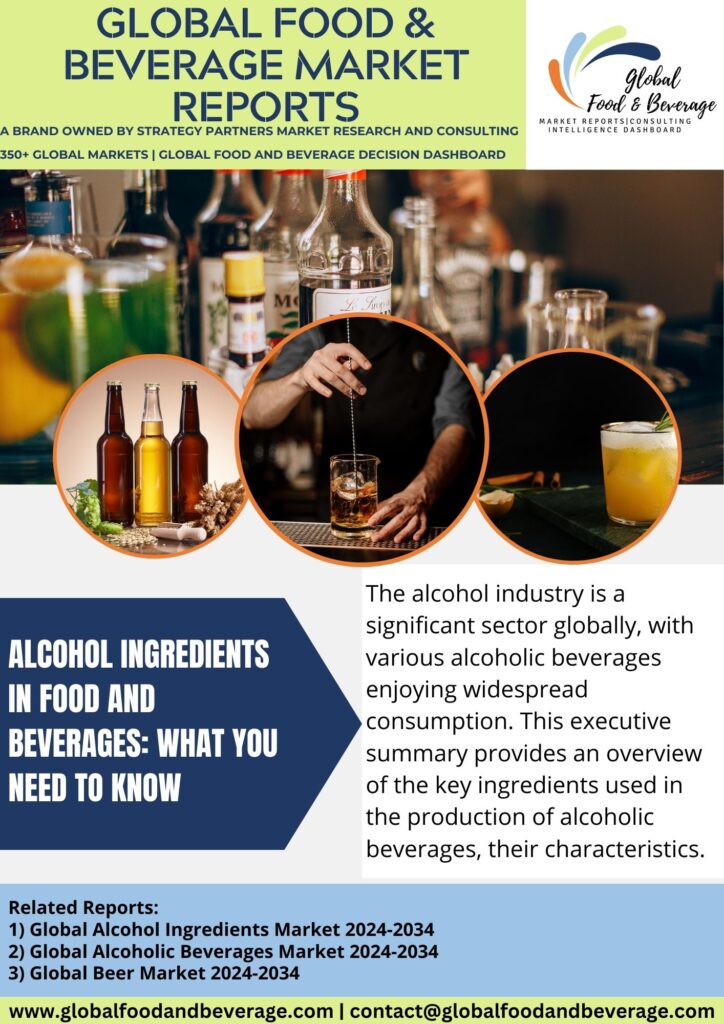Alcohol Ingredients in Food and Beverages: What You Need to Know
Alcohol is a common ingredient in many food and beverages, but many people are unaware of its presence. Alcohol can be found in everything from bread and yogurt to salad dressings and fruit juices.

How Alcohol Gets into Food and Beverages
There are two main ways that alcohol gets into food and beverages. The first is through fermentation. Fermentation is a process in which yeast or bacteria convert sugars into alcohol and carbon dioxide. This is how alcohol is produced in alcoholic beverages such as beer, wine, and liquor. However, fermentation can also occur naturally in foods such as bread, yogurt, and sauerkraut.
The second way that alcohol gets into food and beverages is through addition. Alcohol is sometimes added to food as a flavoring agent or preservative. It can also be used to thicken or emulsify sauces and dressings. Some common foods that contain added alcohol include vanilla extract, soy sauce, and vinegar.
The Amount of Alcohol in Food and Beverages
The amount of alcohol in food and beverages varies widely. Alcoholic beverages, of course, have the highest alcohol content, with beer typically containing around 5% alcohol, wine around 12% alcohol, and liquor around 40% alcohol. Fermented foods typically contain much less alcohol, with bread containing around 1% alcohol and yogurt containing around 0.5% alcohol. Foods with added alcohol can also vary in alcohol content, but it is generally less than 1%.
Is the Alcohol in Food and Beverages Enough to Intoxicate You?
The short answer is no. The amount of alcohol in food and beverages is not enough to intoxicate you. However, if you consume a large amount of food or beverages that contain alcohol, it is possible to experience some of the effects of alcohol, such as drowsiness or dizziness.
What to Look for on Food Labels
If you are concerned about the alcohol content of your food, there are a few things you can look for on food labels. The first is the ingredients list. Look for ingredients such as ethanol, ethyl alcohol, or grain alcohol. These are all different names for alcohol. The second thing you can look for is the nutrition facts panel. The alcohol content of food is not required to be listed on the nutrition facts panel, but some manufacturers do list it voluntarily.
Challenges
Alcohol ingredients play a significant role in the formulation of various food and beverage products, including alcoholic beverages and some culinary dishes. However, the use of alcohol in these applications also presents several challenges.
Regulatory Compliance:
Stringent regulations: The production and sale of alcoholic products are subject to strict regulations, including licensing, labeling, and advertising restrictions. Compliance with these regulations can be challenging for manufacturers.
Alcohol Content Control:
Accurate measurement: Ensuring the precise control of alcohol content in food and beverages, especially in the production of alcoholic drinks, is crucial for regulatory compliance and consumer safety.
Flavor Stability:
Evaporation and volatilization: Alcohol is volatile, and its flavors can evaporate during cooking or processing, leading to a loss of the desired taste profile in the final product.
Allergen Concerns:
Allergenicity: Some individuals may be allergic to certain types of alcohol or components derived from alcohol production, posing challenges for manufacturers in addressing allergen concerns.
Health and Social Considerations:
Health-conscious consumers: Increased awareness of health issues may lead to a decline in the consumption of alcoholic beverages, prompting manufacturers to explore alternatives or reduce alcohol content.
Flavor Masking:
Overpowering taste: In some cases, the strong flavor of alcohol may overpower other ingredients in a food or beverage, making it challenging to achieve a balanced flavor profile.
Cost:
Taxation: Alcohol is often heavily taxed, and this cost is passed on to consumers. Higher costs may impact the affordability of alcoholic products and affect consumer preferences.
Supply Chain Challenges:
Raw material availability: The production of alcohol depends on the availability of raw materials, such as grains or fruits. Fluctuations in the supply chain can affect the consistency and cost of alcohol ingredients.
Cultural and Religious Considerations:
Cultural preferences: Alcoholic beverages may not align with the cultural or religious beliefs of certain consumer groups, limiting market acceptance in specific regions.
Sensory Properties:
Astringency and bitterness: Some alcoholic beverages, particularly those with higher alcohol content, may exhibit astringency or bitterness, which can be challenging to balance in terms of sensory properties.
Sustainability:
Environmental impact: The production of alcoholic beverages can have environmental implications, including water usage, energy consumption, and waste generation. Increasing emphasis on sustainability may require the industry to adopt eco-friendly practices.
Innovation and Trends:
Consumer preferences: Evolving consumer preferences and trends may demand innovations in alcoholic products, such as low-alcohol or alcohol-free alternatives, presenting challenges for traditional producers.
Conclusion
Alcohol is a common ingredient in many foods and beverages. While the amount of alcohol in these foods is usually low, it is still important to be aware of it, especially if you are avoiding alcohol for health or religious reasons.
